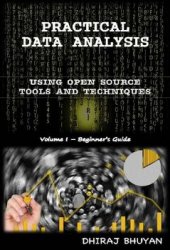 Название: Practical Data Analysis: Using Open Source Tools & Techniques (Volume Book 1)
Название: Practical Data Analysis: Using Open Source Tools & Techniques (Volume Book 1) Автор: Dhiraj Bhuyan
Издательство: Amazon Digital Services LLC
ASIN: B07FNHT42N
Год: 2018
Страниц: 311
Язык: английский
Формат: epub, pdf (conv)
Размер: 16.2 MB
Up until recent years, large technology companies were the main driving force behind the big data revolution. However, other industries are slowly waking up to the opportunities that big data has to offer, as well as to the threat that these technology giants with their intuitive and pleasing goods and services and the depth of their big data capabilities pose to the incumbent’s age old business models. As a result, a slow but visible trend is clearly emerging - more and more companies across all major industry sectors are either exploring or have started to deploy modern data analysis tools and techniques with the sole objective of unravelling and monetising the priceless information that has been locked away in their data warehouses for far too long.
Python and R are amongst the most popular open source programming languages for data analysis. While R’s functionality is developed with statisticians in mind, Python on the other hand is a general purpose programming language, with an easy to understand syntax and a gentle learning curve. Historically, R has been used primarily for academic and research purposes, although anecdotal evidence suggests that R is starting to see some level of adoption in the enterprise world (especially in the Financial Services sector) due to its robust data visualisation capabilities. Python, on the other hand, is widely used in enterprises due to the breadth of its functionalities that span beyond data analytics and also because of the ease with which Python based solutions can be integrated with many other technologies in a typical enterprise set up. Needless to say, due to my enterprise background, I am more inclined towards Python as the data analysis tool of my choice. In addition to Python and R, there is also a wide variety of very powerful commercial data analysis software.
“Practical Data Analysis” uses a case-study based approach to explore the real-world applications of open source data analysis tools and techniques. Specifically, the following topics are covered in this book:
1. Open Source Data Analysis Tools and Techniques.
2. A Beginner’s Guide to “Python” for Data Analysis.
3. Implementing Custom Search Engines On The Fly.
4. Visualising Missing Data.
5. Sentiment Analysis and Named Entity Recognition.
6. Automatic Document Classification, Clustering and Summarisation.
7. Fraud Detection Using Machine Learning Techniques.
8. Forecasting - Using Data to Map the Future.
9. Continuous Monitoring and Real-Time Analytics.
Скачать Practical Data Analysis: Using Open Source Tools & Techniques (Volume Book 1)